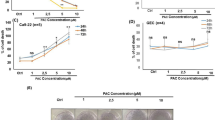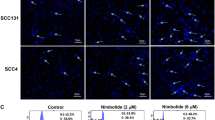Abstract
Carbazole alkaloids, a major constituent of Murraya koenigii (L.) Sprengel (Rutaceae), exhibit biological effects such as anticancer activity via the induction of apoptosis, and they represent candidate chemotherapeutic agents. Oral squamous cell carcinoma (OSCC) is the most prevalent cancer of the oral cavity and a growing and serious health problem worldwide. In this study, we investigated the anticancer properties and mechanisms of action of two carbazole alkaloids derived from M. koenigii leaves, mahanine and isomahanine, in the OSCC cell line CLS-354. At 15 μM, mahanine and isomahanine were cytotoxic to CLS-354 cells, triggering apoptosis via caspase-dependent and -independent mechanisms. Autophagosomes, visualised using monodansylcadaverine (MDC) labelling, were numerous in carbazole alkaloid-treated cells. Mahanine and isomahanine markedly induced the expression of the autophagosome marker microtubule-associated protein 1 light chain 3, type II (LC3B-II). Genetic and chemical inhibition of autophagy via silencing of the Autophagy protein 5 gene and exposure to bafilomycin A1 (BafA1), respectively, did not arrest carbazole alkaloid-induced apoptosis, indicating that it occurs independently of autophagic activation. Surprisingly, both carbazole alkaloids caused increased accumulation of p62/sequestosome1 (p62/SQSTM1), with coordinated expression of LC3B-II and cleaved caspase-3, suggesting inhibition of autophagic flux. Our results suggest that inhibition of autophagic flux is associated with carbazole alkaloid-induced apoptosis. Our findings provide evidence of a novel cytotoxic action of natural carbazole alkaloids and support their use as candidate chemotherapeutic agents for the treatment of OSCC.





Similar content being viewed by others
References
Ramsewak RS, Nair MG, Strasburg GM, Dewitt DL, Nitiss JL (1999) Biologically active carbazole alkaloids from Murraya koenigii. J Agric Food Chem 47:444–447
Choudhury RP, Garg AN (2007) Variation in essential, trace and toxic elemental contents in Murraya koenigii—a spice and medicinal herb from different Indian states. Food Chem 104:1454–1463
Gupta P, Nahata A, Dixit VK (2011) An update on Murraya koenigii Spreng: a multifunctional Ayurvedic herb. J Chin Integr Med 9:824–833
Rao LJM, Ramalakshmi K, Borse BB, Raghavan B (2007) Antioxidant and radical-scavenging carbazole alkaloids from the oleoresin of curry leaf (Murraya koenigii Spreng.). Food Chem 100:742–747
Rahman MM, Gray AI (2005) A benzoisofuranone derivative and carbazole alkaloids from Murraya koenigii and their antimicrobial activity. Phytochemistry 66:1601–1606
Mandal S, Nayak A, Kar M, Banerjee SK, Das A, Upadhyay SN, Singh RK, Banerji A, Banerji J (2010) Antidiarrhoeal activity of carbazole alkaloids from Murraya koenigii Spreng (Rutaceae) seeds. Fitoterapia 81:72–74
Yankuzo H, Ahmed QU, Santosa RI, Akter SFU, Talib NA (2011) Beneficial effect of the leaves of Murraya koenigii (Linn.) Spreng (Rutaceae) on diabetes-induced renal damage in vivo. J Ethnopharmacol 135:88–94
Sarkar S, Dutta D, Samanta SK, Bhattacharya K, Pal BC, Li J, Datta K, Mandal C, Mandal C (2013) Oxidative inhibition of Hsp90 disrupts the super-chaperone complex and attenuates pancreatic adenocarcinoma in vitro and in vivo. Int J Cancer 132:695–706
Ito C, Itoigawa M, Nakao K, Murata T, Tsuboi M, Kaneda N, Furukawa H (2006) Induction of apoptosis by carbazole alkaloids isolated from Murraya koenigii. Phytomedicine 13:359–365
Roy MK, Thalang VN, Trakoontivakorn G, Nakahara K (2004) Mechanism of mahanine-induced apoptosis in human leukemia cells (HL-60). Biochem Pharmacol 67:41–51
Sinha S, Pal BC, Jagadeesh S, Banerjee PP, Bandyopadhaya A, Bhattacharya S (2006) Mahanine inhibits growth and induces apoptosis in prostate cancer cells through the deactivation of Akt and activation of caspases. Prostate 66:1257–1265
Das R, Bhattacharya K, Samanta SK, Pal BC, Mandal C (2014) Improved chemosensitivity in cervical cancer to cisplatin: synergistic activity of mahanine through STAT3 inhibition. Cancer Lett 351:81–90
Bhattacharya K, Samanta SK, Tripathi R, Mallick A, Chandra S, Pal BC, Shaha C, Mandal C (2010) Apoptotic effects of mahanine on human leukemic cells are mediated through crosstalk between Apo-1/Fas signaling and the Bid protein and via mitochondrial pathways. Biochem Pharmacol 79:361–372
Ferlay J, Soerjomataram I, Ervik M, Dikshit R, Eser S, Mathers C, Rebelo M, Parkin DM, Forman D, Bray F (2013) GLOBOCAN 2012 v1.0, cancer incidence and mortality worldwide. IARC CancerBase No. 11. http://globocan.iarc.fr
Massano J, Regateiro FS, Januário G, Ferreira A (2006) Oral squamous cell carcinoma: review of prognostic and predictive factors. Oral Surg Oral Med Oral Pathol 102:67–76
Jerjes W, Upile T, Petrie A, Riskalla A, Hamdoon Z, Vourvachis M, Karavidas K, Jay A, Sandison A, Thomas GJ, Kalavrezos N, Hopper C (2010) Clinicopathological parameters, recurrence, locoregional and distant metastasis in 115 T1–T2 oral squamous cell carcinoma patients. Head Neck Oncol 2:9
Wang B, Zhang S, Yue K, Wang XD (2013) The recurrence and survival of oral squamous cell carcinoma: a report of 275 cases. Chin J Cancer 32:614–618
Chen S, Rehman SK, Zhang W, Wen A, Yao L, Zhang J (2010) Autophagy is a therapeutic target in anticancer drug resistance. Biochem Biophys Acta 1806:220–229
Millimouno FM, Dong J, Yang L, Li J, Li X (2014) Targeting apoptosis pathways in cancer and perspectives with natural compounds from mother nature. Cancer Prev Res (Phila) 7:1081–1107
Lin CS, Wang YC, Huang JL, Hung CC, Chen JYF (2012) Autophagy and reactive oxygen species modulate cytotoxicity induced by suppression of ATM kinase activity in head and neck cancer cells. Oral Oncol 48:1152–1158
Xu D, Lao Y, Xu N, Hu H, Fu W, Tan H, Gu Y, Song Z, Cao P, Xu H (2015) Identification and characterization of anticancer compounds targeting apoptosis and autophagy from Chinese native Garcinia species. Planta Med 81:79–89
Ren G, Sha T, Guo J, Li W, Lu J, Chen X (2015) Cucurbitacin B induces DNA damage and autophagy mediated by reactive oxygen species (ROS) in MCF-7 breast cancer cells. J Nat Med 69:522–530
Law BY, Chan WK, Xu SW, Wang JR, Bai LP, Liu L, Wong VK (2014) Natural small-molecule enhancers of autophagy induce autophagic cell death in apoptosis-defective cells. Sci Rep 4:5510
Qiu W, Su M, Xie F, Ai J, Ren Y, Zhang J, Guan R, He W, Gong Y, Guo Y (2014) Tetrandrine blocks autophagic flux and induces apoptosis via energetic impairment in cancer cells. Cell Death Dis 5:e1123
Reisch J, Goj O, Wickramasinghe A, Herath HB, Henkel G (1992) Carbazole alkaloids from seeds of Murraya koenigii. Phytochemistry 31:2877–2879
Tachibana Y, Kikuzaki H, Lajis NH, Nakatani N (2001) Antioxidative activity of carbazoles from Murraya koenigii leaves. J Agric Food Chem 49:5589–5594
Samanta SK, Dutta D, Roy S, Bhattacharya K, Sarkar S, Dasgupta AK, Pal BC, Mandal C, Mandal C (2013) Mahanine, a DNA minor groove binding agent exerts cellular cytotoxicity with involvement of C-7-OH and -NH functional groups. J Med Chem 56:5709–5721
Mukhopadhyay S, Panda PK, Sinha N, Das DN, Bhutia SK (2014) Autophagy and apoptosis: where do they meet? Apoptosis 19:555–566
Pradelli LA, Bénéteau M, Ricci JE (2010) Mitochondrial control of caspase-dependent and -independent cell death. Cell Mol Life Sci 67:1589–1597
Munafó DB, Colombo MI (2001) A novel assay to study autophagy: regulation of autophagosome vacuole size by amino acid deprivation. J Cell Sci 114:3619–3629
Fukui M, Yamabe N, Choi HJ, Polireddy K, Chen Q, Zhu BT (2015) Mechanism of ascorbate-induced cell death in human pancreatic cancer cells: role of bcl-2, beclin 1 and autophagy. Planta Med 81:838–846
Otomo C, Metlagel Z, Takaesu G, Otomo T (2013) Structure of the human ATG12~ATG5 conjugate required for LC3 lipidation in autophagy. Nat Struct Mol Biol 20:59–66
Zhang XJ, Chen S, Huang KX, Le WD (2013) Why should autophagic flux be assessed? Acta Pharmacol Sin 34:595–599
Bjørkøy G, Lamark T, Pankiv S, Øvervatn A, Brech A, Johansen T (2009) Monitoring autophagic degradation of p62/SQSTM1. Methods Enzymol 452:181–197
Boya P, González-Polo RA, Casares N, Perfettini JL, Dessen P, Larochette N, Métivier D, Meley D, Souquere S, Yoshimori T, Pierron G, Codogno P, Kroemer G (2005) Inhibition of macroautophagy triggers apoptosis. Mol Cell Biol 25:1025–1040
Yuan N, Song L, Zhang S, Lin W, Cao Y, Xu F, Fang Y, Wang Z, Zhang H, Li X, Wang Z, Cai J, Wang J, Zhang Y, Mao X, Zhao W, Hu S, Chen S, Wang J (2015) Bafilomycin A1 targets both autophagy and apoptosis pathways in pediatric B-cell acute lymphoblastic leukemia. Haematologica 100:345–356
He PX, Che YS, He QJ, Chen Y, Ding J (2014) G226, a novel epipolythiodioxopiperazine derivative, induces autophagy and caspase-dependent apoptosis in human breast cancer cells in vitro. Acta Pharmacol Sin 35:1055–1064
Mader BJ, Pivtoraiko VN, Flippo HM, Klocke BJ, Roth KA, Mangieri LR, Shacka JJ (2012) Rotenone inhibits autophagic flux prior to inducing cell death. ACS Chem Neurosci 3:1063–1072
Lim J, Lee Y, Kim HW, Oh MS, Youdim MB, Yue Z, Oh YJ (2012) Nigericin-induced impairment of autophagic flux in neuronal cells is inhibited by overexpression of Bak. J Bio Chem 287:23271–23282
Geng Y, Kohli L, Klocke BJ, Roth KA (2010) Chloroquine-induced autophagic vacuole accumulation and cell death in glioma cells is p53 independent. Neuro Oncol 12:473–481
Acknowledgements
This work was supported by the programme strategic scholarships fellowships frontier research networks for the Ph.D. sandwich programme doctoral degree from the Office of the Higher Education Commission (OHEC), Thailand (06/2556); Walailak University (WU56113); Walailak University Fund for graduate studentship (27/2556 and WU55603); The Thailand Research Fund (DBG5980003); Centre of Excellence for Innovation in Chemistry, OHEC. We would like to thank Enago (https://www.enago.com/) for editing and reviewing this manuscript for English language.
Author information
Authors and Affiliations
Corresponding author
Ethics declarations
Conflict of interest
The authors declare no conflicts of interest.
Electronic supplementary material
Below are the links to the electronic supplementary material.
Rights and permissions
About this article
Cite this article
Utaipan, T., Athipornchai, A., Suksamrarn, A. et al. Carbazole alkaloids from Murraya koenigii trigger apoptosis and autophagic flux inhibition in human oral squamous cell carcinoma cells. J Nat Med 71, 158–169 (2017). https://doi.org/10.1007/s11418-016-1045-6
Received:
Accepted:
Published:
Issue Date:
DOI: https://doi.org/10.1007/s11418-016-1045-6




